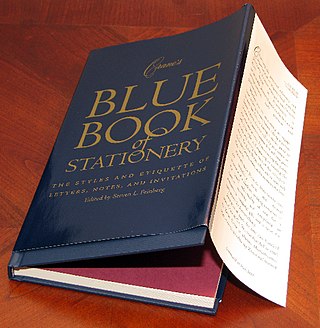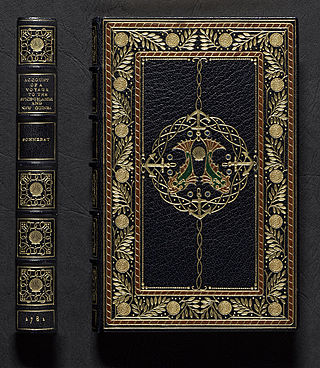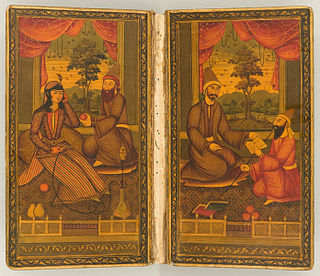
Library binding can be divided into the two major categories of "original" and "after market". The original category is as it says: the book was originally bound with the idea that it would be used in a library setting where the book would receive harder use than those usual trade editions sold to the public.

The dust jacket of a book is the detachable outer cover, usually made of paper and printed with text and illustrations. This outer cover has folded flaps that hold it to the front and back book covers.

A treasure binding or jewelled bookbinding is a luxurious book cover using metalwork in gold or silver, jewels, or ivory, perhaps in addition to more usual bookbinding material for book-covers such as leather, velvet, or other cloth. The actual bookbinding technique is the same as for other medieval books, with the folios, normally of vellum, stitched together and bound to wooden cover boards. The metal furnishings of the treasure binding are then fixed, normally by tacks, onto these boards. Treasure bindings appear to have existed from at least Late Antiquity, though there are no surviving examples from so early, and Early Medieval examples are very rare. They were less used by the end of the Middle Ages, but a few continued to be produced in the West even up to the present day, and many more in areas where Eastern Orthodoxy predominated. The bindings were mainly used on grand illuminated manuscripts, especially gospel books designed for the altar and use in church services, rather than study in the library.

A book cover is any protective covering used to bind together the pages of a book. Beyond the familiar distinction between hardcovers and paperbacks, there are further alternatives and additions, such as dust jackets, ring-binding, and older forms such as the nineteenth-century "paper-boards" and the traditional types of hand-binding. The term "Bookcover" is often used for a book cover image in library management software. This article is concerned with modern mechanically produced covers.

A bookmark is a thin marking tool, commonly made of card, leather, or fabric, used to keep track of a reader's progress in a book and allow the reader to easily return to where the previous reading session ended. Alternate materials for bookmarks are paper, metals like silver and brass, silk, wood, cord (sewing), and plastic. Some books may have one or more bookmarks made of woven ribbon sewn into the binding. Furthermore, other bookmarks incorporate a page-flap that enables them to be clipped on a page.

Coptic binding or Coptic sewing comprises methods of bookbinding employed by early Christians in Egypt, the Copts, and used from as early as the 2nd century AD to the 11th century. The term is also used to describe modern bindings sewn in the same style.

In bookbinding, finishing refers to the process of decorating the outside of a book, including the lettering of the spine and covers, any additional tooling, and any inlays and onlays. Finishing can also include the gilding or other decoration of the edges of the book's pages.
Oversewn bindings are a type of bookbinding produced by sewing together loose leaves of paper to form a text block. Threads pass through small holes that have been punched in the signature's gutter margin, forming overlock stitches that attach it to previously attached sections. This method of stitching is sometimes called stab sewing. A piece of linen is then glued to the text block spine for further support. The book's spine may be rounded and backed to keep it from caving in, but if the text block is too thick, the spine is sometimes left flat. A strip of cloth called a super is then often affixed to the spine of the text block and then to the boards of the case. Oversewing can be done by hand but is usually done with a machine in a bindery.

Limp binding is a bookbinding method in which the book has flexible cloth, leather, vellum, or (rarely) paper sides. When the sides of the book are made of vellum, the bookbinding method is also known as limp vellum.

Bookbinding is the process of building a book of codex manuscripts from an ordered stack of paper sheets with one's hands and tools. Firstly, one binds the sheets of papers along an edge with a thick needle and strong thread. One can also use loose-leaf rings, binding posts, twin-loop spine coils, plastic spiral coils, and plastic spine combs, but they last for a shorter time. Next, one encloses the bound stack of paper in a cover. Finally, one places an attractive cover onto the boards, and features the publisher's information and artistic decorations.

Sangorski & Sutcliffe is a firm of bookbinders established in London in 1901. It is considered to be one of the most important bookbinding companies of the 20th century, famous for its luxurious jeweled bindings that used real gold and precious stones in their book covers.

Book rebinding is the renewal or replacement of the cover of a book. Typically, this requires restitching or renewal of the glue which holds the pages in place.
Thomas Mahieu, also known as Thomas Maiolus, was a French courtier and bibliophile with a special interest in decorative bookbindings.
Katharine Adams was a British bookbinder famous for her detailed leather bindings.

Doublures are ornamental linings on the inside of a book. Doublures are protected from wear, compared to the outside of a book, and thus offer bookbinders scope for elaborate decoration.
Claude de Picques was an influential French bookbinder. He was closely connected with the court of King Henry II of France, serving as the personal bookbinder to Queen Catherine de' Medici from 1553 and as the personal bookbinder to the King himself from 1556 to 1574. He is thought also to have been one of the binders who worked for Thomas Mahieu.

George A. Baer was a German/Swiss/American bookbinder. He specialized in fine leather bindings, including inlays and gold tooling.

August Sandgren was a Danish bookbinder. He was one of the best craftsmen of Denmark and a great designer who never compromised with the techniques of bookbinding.
Christine Elizabeth Florence Greenhill was an English bookbinder. She did bookbinding following her encouragement from her sister to enrol on bookbinding classes until the Second World War broke out when she became a full-time air raid warden and thus had little time to do bookbinding. Greenhill returned to bookbinding soon after the war was over and served as honorary secretary of the Guild of Contemporary Bookbinders before being elected its president for a single term. The Bodleian Library has held two collections of boxes relating to her life and career in its Libraries Repository since 2009.
Bernard Chester Middleton was a preeminent British restoration bookbinder. He was regarded as one of the foremost book craftsmen and trade historians of modern times, lecturing and teaching in Europe and the Americas. He authored two major works, A History of English Craft Bookbinding Technique (1963) and The Restoration of Leather Bindings (1972), which became essential reading for professional bookbinders, scholars and collectors.















